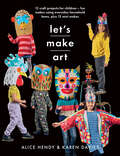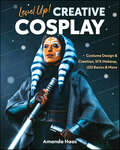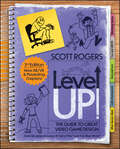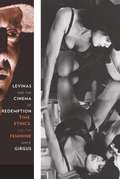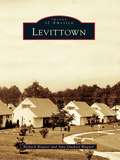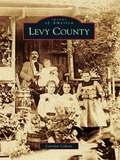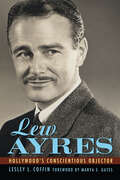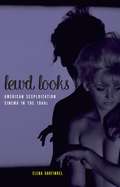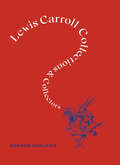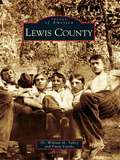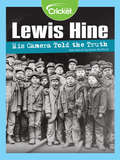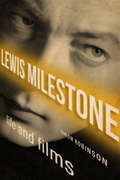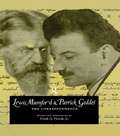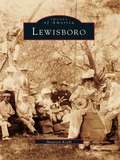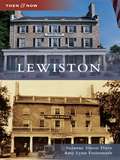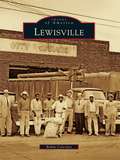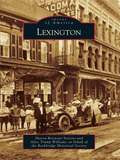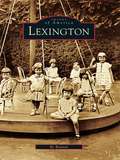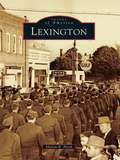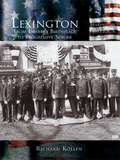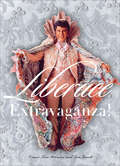- Table View
- List View
Let’s Dance
by George AnconaAncona begins by introducing various musical instruments to set the rhythms for multicultural, multigenerational dances. All of the movements are described through a simple text in a large-print format
Let’s Make Art: 12 Craft Projects for Children (Crafts Ser.)
by Alice Hendy Karen Louise DaviesThis book offers families a cherry picked selection of Alice and Karen’s tried and tested art projects with clear instructions on how to make them at home. They reveal their top tips for creating stunning art work that parents and children will want to keep and display (rather than consign to the recycling bin)! All the projects use a household item as the starting point, making the activities largely accessible. Within this framework the book is organised into sections according to the time scale of the project to help families make the most of the time they have available beginning with shorter projects. A comprehensive but affordable kit list is part of the introduction and includes many items families will already own. Along with a basic kit list Alice and Karen spill a few in house secrets about their go-to materials for maximum impact and a professional finish. Plastic materials are kept to a minimum. Let’s Make Art champion sustainable, recycled art projects with their home based starting point for projects. This craft book for children and their families is a unique addition to the market as it elevates children’s art to the status it deserves by showing children how to achieve bold work with a professional finish. The projects are cheeky, flamboyant and have their own very particular style, especially the costumes and wearable artwork. Having worked for galleries, libraries and restaurants Let’s Make Art have amassed an array of art projects that avoid messy clearing up for parents and children.
Level Up! Creative Cosplay: Costume Design & Creation, SFX Makeup, LED Basics & More
by Amanda HaasExpand your costume-making skills and go from beginner to confident maker! Picking up where Creative Cosplay left off, this new volume prepares costume enthusiasts to create out-of-this-world effects from head to toe! Cosplayers of all experience levels have much to gain from Amanda’s expertise as a national cosplay competition winner and judge. Learn the basics of making an original costume pattern, using prosthetics and latex, and customizing fabric through dyeing and painting. Transform yourself into the character of your choice with Special Effects (SFX) makeup. SFX makeup uses prosthetics and smaller on-skin materials to create illusions — such as wounds, scars, deformities, or supernatural features — directly on the skin. Get the scoop on sergers, embroidery machines, and using a digital cutter Pick up industry secrets on the basics of LED work, body painting, and SFX makeup Create a DIY costume repair kit for conventions, and market yourself in the cosplay world
Level Up! The Guide to Great Video Game Design
by Scott RogersWant to design your own video games? Let expert Scott Rogers show you how! If you want to design and build cutting-edge video games but aren't sure where to start, then the THIRD EDITION of the acclaimed Level Up! is for you! Written by leading video game expert Scott Rogers, who has designed for the hits Pac-Man World, God of War, Maximo and SpongeBob SquarePants, this updated edition provides clear and well-thought-out examples that forgo theoretical gobbledygook with charmingly illustrated concepts and solutions based on years of professional experience. Level Up! 3rd Edition has been NEWLY EXPANDED to teach you how to develop marketable ideas, learn what perils and pitfalls await during a game's pre-production, production and post-production stages, and provide even more creative ideas to serve as fuel for your own projects including: Developing your game design from the spark of inspiration all the way to production Learning how to design the most exciting levels, the most precise controls, and the fiercest foes that will keep your players challenged Creating games for console, mobile, and VR/AR/MR—including detailed rules for game play design and controls Monetizing your game from the design up Play test your game to get the best feedback from your players Level Up! 3rd Edition features all-new content, including two new chapters and even a brand-new chili recipe—making it the most indispensable guide for video game designers both “in the field” and the classroom.
Levinas and the Cinema of Redemption: Time, Ethics, and the Feminine (Film and Culture Series)
by Sam GirgusIn his philosophy of ethics and time, Emmanuel Levinas highlighted the tension that exists between the "ontological adventure" of immediate experience and the "ethical adventure" of redemptive relationships-associations in which absolute responsibility engenders a transcendence of being and self. In an original commingling of philosophy and cinema study, Sam B. Girgus applies Levinas's ethics to a variety of international films. His efforts point to a transnational pattern he terms the "cinema of redemption" that portrays the struggle to connect to others in redeeming ways. Girgus not only reveals the power of these films to articulate the crisis between ontological identity and ethical subjectivity. He also locates time and ethics within the structure and content of film itself. Drawing on the work of Luce Irigaray, Tina Chanter, Kelly Oliver, and Ewa Ziarek, Girgus reconsiders Levinas and his relationship to film, engaging with a feminist focus on the sexualized female body. Girgus offers fresh readings of films from several decades and cultures, including Frank Capra's Mr. Smith Goes to Washington (1939), Federico Fellini's La dolce vita (1959), Michelangelo Antonioni's L'avventura (1960), John Huston's The Misfits (1961), and Philip Kaufman's The Unbearable Lightness of Being (1988).
Levittown (Images of America)
by Richard Wagner Amy Duckett WagnerIn 1951, Levittown was created in Bucks County outside of Philadelphia by builder pioneers Levitt and Sons. Dubbed the largest and "most perfectly planned" community in America, it featured single-family homes, schools, churches, shopping centers, and swimming pools. A symbol of the "American Dream," Levittown defined the phenomenon of post-World War II suburban developments, which for the first time gave working- and middle-class families the option of affordable, detached houses outside congested urban neighborhoods. Levittown was a melting pot, attracting people from cities, rural areas, and all walks of life, including many World War II veterans with young families. Houses came fully equipped with appliances and landscaping and started at $9,000. Levittown's superb collection of history and photographs illustrates the birth and growth of this unique area, explores the community that resulted, and features residents' personal memories of the golden years.
Levy County
by Carolyn CohensLevy County was founded in 1845 and was named after Florida's first senator, David Levy Yulee. Levy County is a visitor's paradise with the small island of Cedar Key's romantic charm, shops, restaurants, festivals, and art galleries, as well as Chiefland's Train Depot Museum, Suwannee Valley Theater, Watermelon Festival, Christmas Parade of Lights, and Williston Peanut Festival. The woods of Levy County are a sportsman's paradise for hunting and fishing, and divers come from near and far to explore and enjoy the underwater caves of Manatee Springs Park.
Levy County, Florida (Black America Series)
by Carolyn CohensDriving along Levy County highways, one can always see crops of corn, watermelons, peanuts, cantaloupes, and vegetables. The county contains the cities of Cedar Key, noted for its romantic atmosphere and annual seafood and art festivals; Chiefland, a small town with a friendly atmosphere; and Rosewood, noted today for its tours and markers dedicated to those who tragically lost their lives.
Lew Ayres: Hollywood's Conscientious Objector (Hollywood Legends Series)
by Lesley L. CoffinLew Ayres (1908-1996) became known to the public when he portrayed the leading character in the epic war film All Quiet on the Western Front. The role made him a household name, introduced him to his closest friends, brought him to the attention of his first two wives, and would overshadow the rest of his career. To be a movie star was his first and only ambition as a child, but once he found success, he was never fully satisfied in his choice of profession. Although lacking a formal education, Ayres spent the rest of his life pursuing dozens of intellectual studies, interests, and hobbies. He even considered ended his acting career after just a few years to pursue a more “respectable and fulfilling” path as a director. Ayres was given not one but two comeback opportunities in his acting career, in 1938 and 1945. He was cast in the film series Dr. Kildare where he showed his abilities in comedy and his unique strength at bringing a level of sincerity to even the most outlandish or idealist character. But he was willing to give up his star status to follow his moral compass, first as a conscientious objector and ultimately as a noncombat medic during World War II. To everyone’s surprise, he was welcomed back to Hollywood with open arms and new opportunities despite his objector status. Biographer Lesley L. Coffin presents the story of a man of quiet dignity, constantly searching for the right way to live his life and torn between the public world of Hollywood and secluded life of spiritual introspection.
Lew Hunter's Screenwriting 434
by Lew HunterFor decades, Lew Hunter's Screenwriting 434 class at UCLA has been the premier screenwriting course, launching a generation of the industry's most frequently produced writers. Here, he shares the secrets of his course on the screenwriting process by actually writing an original script, step by step, that appears in the book.
Lewd Looks: American Sexploitation Cinema in the 1960s
by Elena GorfinkelOne of the most fascinating phenomena of 1960s film culture is the emergence of American sexploitation films—salacious indies made on the margins of Hollywood. Hundreds of such films were produced and shown on both urban and small-town screens over the course of the decade. Yet despite their vital importance to the film scene, and though they are now understood as a gateway to the emergence of publicly exhibited hardcore pornography in the early 1970s, these films have been largely overlooked by scholars.Defined by low budgets, quick production times, unknown actors, strategic uses of nudity, and a sensationalist obsession with unbridled female sexuality, sexploitation films provide a unique window into a tumultuous period in American culture and sexual politics. In Lewd Looks, Elena Gorfinkel examines the social and legal developments that made sexploitation films possible: their aesthetics, their regulation, and their audiences. Gorfinkel explores the ways sexploitation films changed how spectators encountered and made sense of the sexualized body and set the stage for the adult film industry of today. Lewd Looks recovers a lost chapter in the history of independent cinema and American culture—a subject that will engross readers interested in media, sexuality, gender, and the 1960s. Gorfinkel investigates the films and their contexts with scholarly depth and vivid storytelling, producing a new account of the obscene image, screen sex, and adult film and media.
Lewis Carroll: Collections and Collectors
by Edward GuilianoThis is the first book on the history and culture of collecting the works of Lewis Carroll as well as the worldwide industry of items and art based on Carroll&’s works in popular culture. Ten large, major private collections from around the world are profiled, telling the story of each collection and collector, with color illustrations of objects from the collections. The volume, which also covers smaller specialized collections and includes a comprehensive introduction to the history and characteristics of collecting Carrolliana, will appeal to Carroll enthusiasts and rare book and memorabilia collectors alike.
Lewis County (Images of America)
by Paula Franke Dr William TalleyLewis County, located in far northeastern Kentucky, was formed in 1806 and named for explorer Meriwether Lewis. The county was once teeming with industry as a supplier of finished goods and agricultural products. Historically, the county's proximity to the Ohio River allowed the export oftimber and salt, and in the 1800s, railroad transportation made Lewis County an influential source of railroad ties, boat-building materials, and barrels. In later years, the area was most popular for its health resorts, spas, and "sulfur waters," which attracted visitors from as far as New York and Chicago. The images in this volume depict the county's military influence, as Lewis Countians had strong allegiance to the Union during the Civil War. The photographs featured in Images of America: Lewis County have been drawn from the archive of the Vanceburg DepotMuseum and from various private collections.
Lewis Hine: His Camera Told the Truth
by James RumfordIt was once common for children to work at jobs with little pay. Then a photographer named Lewis Hine urged this dangerous practice stop to with the power of his camera and the assistance of lawmakers. Learn more about the history of child labor in the United States and how it became outlawed.
Lewis Milestone: Life and Films (Screen Classics)
by Harlow RobinsonA biography of the Oscar-winning director and a study of his acclaimed films, like All Quiet on the Western Front, The Front Page, and Of Mice and Men. This comprehensive biography is the first to present Lewis Milestone&’s remarkable life—a classic rags-to-riches American narrative—in full and explores his many acclaimed films from the silent to the sound era. Creator of All Quiet on the Western Front, Of Mice and Men, the original Ocean&’s Eleven and Mutiny on the Bounty, Lewis Milestone (1895-1980) was one of the most significant, prolific, and influential directors of our time. A serious artist who believed in film&’s power not only to entertain, but also to convey messages of social importance, Milestone was known as a man of principle in an industry not always known for an abundance of virtue. Born in Ukraine, Milestone came to America as a tough, resourceful Russian-speaking teenager and learned about film by editing footage from the front as a member of the Signal Corps of the US Army during World War I. During the course of his film career, which spanned more than 40 years, Milestone developed intense personal and professional relationships with such major Hollywood figures as Howard Hughes, Kirk Douglas, Marlene Dietrich, and Marlon Brando. Addressed are Milestone&’s successes?he garnered 28 Academy Award nominations?as well as his challenges. Using newly available archival material, this work also examines Milestone&’s experience during the Hollywood Blacklist period, when he was one of the first prominent Hollywood figures to fall under suspicion for his alleged Communist sympathies.Praise for Lewis Milestone&“This highly readable biography of Lewis Milestone delivers the definitive study of a leading Jewish émigré director in Hollywood from the 1920s to the 1960s who worked successfully across multiple genres. Robinson seamlessly layers the scholarly expertise of a noted film historian of Russia and the Soviet Union with a novelist&’s gift for narrative power and dramatic flair, bringing long overdue attention to Milestone&’s fascinating life and enduring artistic achievements.&” —Catherine Portuges, University of Massachusetts Amherst&“A welcome biography of a man whose films remain better known than his name . . . . Robinson concentrates on the key aspects of Milestone&’s life and career, never getting bogged down in plot synopses or other minor issues. Rather than shoveling up endless rubble, he offers us the milestones of Milestone. Robinson&’s story is as tight as most classic Hollywood films, and that deserves to be heralded. This is a book equally as valuable to film buffs as to academic scholars, speaking to readers inside and outside the academy.&” —LA Review of Books
Lewis Mumford and Patrick Geddes: The Correspondence
by Frank G. NovakFirst published in 1995. Routledge is an imprint of Taylor & Francis, an informa company.
Lewisboro
by Maureen KoehlThe history of a town is found in the faces of its people and the places familiar to them. It is the story of the families that lived, worked, and played together over the years. With Lewisboro, the reader is invited to take a fascinating step back in time to view the history of this Westchester County town as it unfolds. The town is divided into six hamlets that are each proud of their unique heritage: Vista, Lewisboro, South Salem, Waccabuc, Cross River, and Goldens Bridge. Primarily a rural farm community in the nineteenth and early twentieth centuries, the introduction of the New York City Reservoir System and improved highways changed Lewisboro in many ways. Its lakes became lake communities offering affordable vacation homes; its farms became neighborhoods; and the railroad made commuting a way of life. Slowly the town grew.
Lewiston
by Amy Lynn Freiermuth Suzanne Simon DietzLewiston, New York, a village and town on the mighty Niagara River, was destroyed during the War of 1812. Rebuilding began in the embers from that war, and the ongoing transformation has created a popular tourist destination for music, theater, festivals, and more. Historian Suzanne Simon Dietz and photographer Amy Lynn Freiermuth combined their talents to create Lewiston by selecting images from local museums, libraries, newspaper archives, and private collections.
Lewisville (Images of America)
by Robin Cole-JettOriginally known as Holford's Prairie, Lewisville's name is not the only thing that has changed about this town in its long history. Settlers sponsored by the Peters Colony Company founded the small community in the 1840s. In the ensuing years, the settlement, renamed to Lewisville by Basdeal W. Lewis in 1856, consistently grew and prospered until its incorporation in 1925. Cotton farming and ginning, the arrival of the Dallas and Wichita Railroad in 1881, the expansion of Lake Dallas into Lake Lewisville in 1954, and the opening of the Dallas/Fort Worth International Airport in 1974 ensured that Lewisville became an important commercial center in booming North Texas. Throughout its phenomenal growth, however, Lewisville still retained the charm and bonds of its farm-centered past. Today Lewisville boasts the largest population and school district in Denton County and serves as a suburb for the bustling Dallas/Fort Worth Metroplex.
Lexington
by Rockbridge Historical Society Sharon Ritenour Stevens Alice Trump WilliamsLexington, the seat for Rockbridge County, is situated in the beautiful Shenandoah Valley within minutes of the Blue Ridge Mountains. Main Street is part of Route 11--the Valley Pike/Great Road--and the architecture downtown looks much as it did in the 19th century. Lexington is home to Washington and Lee University and Virginia Military Institute. It is also the final resting place for Thomas "Stonewall" Jackson and Robert E. Lee, as well as their horses. Within a few blocks, one visits the Stonewall Jackson House, Lee Chapel Museum, the VMI Museum, and the George C. Marshall Library Museum.
Lexington
by Bo BennettLexington, North Carolina, heralded as the "Barbecue Capital of the World," is located in the heart of the Triad, just 30 miles from High Point, Winston-Salem, and Greensboro. Along with barbecue, the town enjoys a rich history in the furniture business and textile industry. Legend claims that the European families who made Lexington their home in the early 1700s named it after a battle of the American Revolution. On April 19, 1775, the brave soldiers of Lexington, Massachusetts, armed themselves and courageously fought the British, losing seven American lives. News of their courage reached North Carolina, and it was decided to name the town in honor of the place whereone of the first known British resistances occurred.
Lexington
by Sharon R. PaethOriginally known as Saxe Gotha Township when it was created by the Colonial government in 1735, Lexington has a unique and rich history. The county began simply as a buffer between the city of Charleston and the Native Americans. Creative locals built a thriving business community in the area around the Congaree River in present-day Cayce, supporting trade between the colonists and the Native Americans. Emigrants from Germany and Switzerland were invited to become pioneers. They were independent, hard-working farmers who built the area into a strong and sustaining home despite numerous trials and tribulations. Native American wars, fires, Civil War, depressions, and world wars only solidified these settlers' strong sense of ownership and pride in their county. Today visitors enjoy over 50 historical sites and recreation facilities.
Lexington, Kentucky: Changes in the Early Twentieth Century (Postcard History)
by Wynelle DeeseFrom the 1890s through the 1920s, the postcard was an extraordinarily popular means of communication, and many of the postcards produced during this "golden age" can today be considered works of art. Postcard photographers traveled the length and breadth of the nation snapping photographs of busy street scenes, documenting local landmarks, and assembling crowds of friends and neighbors only too happy to pose for a picture. These images, printed as postcards and sold in general stores across the country, survive as telling reminders of an important era in America's history. This fascinating new history of Lexington, Kentucky, showcases more than two hundred of the best vintage postcards available.
Lexington: From Liberty's Birthplace to Progressive Suburb
by Richard KollenA quiet colonial town forever changed by the shot heard 'round the world on April 19, 1775, Lexington evolved from its famous roots and adapted to the ever-changing culture of the nation it helped create. Over the centuries, an influx of immigrants and new ideas helped shape the town from farming community to booming rail suburb and into today's diverse city that treasures its rich heritage while striving toward a dynamic future.
Liberace Extravaganza!
by Connie Furr Soloman Jan JewettKnown for his spectacular performances, the magnificent Wladziu Valentino Liberace was a world-renowned star in the entertainment industry for more than four decades, and his dazzling, often outrageous costumes are what made him most memorable. In Liberace Extravaganza! the entertainer's sequined, bejeweled, and rhinestone-studded outfits, as well as his extravagant collection of furs, feather capes, sparkling bow ties, and custom-made shoes are exhibited in book form for the very first time.These mesmerizing costumes grew from Liberace's humble beginnings when, as a young man, he would perform in his brother's hand-me-downs. From there, his suits, worth as much as twenty-four thousand dollars, featured layers of silk and satin ruffles, Swarovski crystal rhinestones, and fourteen-karat white-gold, diamond-encrusted buttons, culminating in his "electric" costumes with four thousand light bulbs weighing more than twenty-five pounds.Michael Travis, Liberace's principal designer, has written the foreword for this breathtaking volume. Jim Lapidus, another of Liberace's designers, furrier Anna Nateece, and Ray Arnett, his producer, have contributed original sketches used to design Liberace's costumes. The result is a book that is one of a kind: a celebration of the legendary performer and a visual feast of the most extraordinary costumes ever created.With more than 260 full-color photographs

